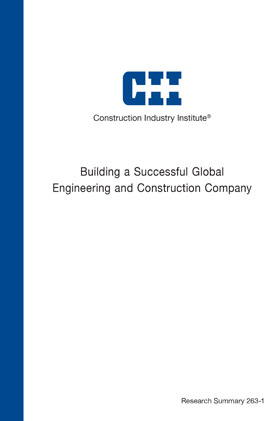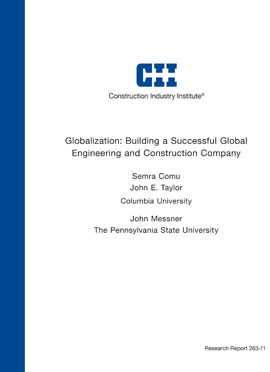
Building a Successful Global Engineering and Construction Company
The globalization of engineering and construction (E&C) services is a part of the much broader market trend toward the globalization of all services; this larger trend has had far-reaching impacts in recent decades on work practices, workforce demographics, the economy, and society. In the engineering and construction industry, discussions of globalization have centered largely on two main topics: (1) the outsourcing of services from offshore service providers, such as low-cost engineering centers, and (2) the increasing project scope of global projects—their larger size and greater complexity require the participation of engineers, contractors, and suppliers from several countries. Yet, a third important trend in the globalization of the industry deserves further investigation: the market issues that U.S. organizations face as they expand into other countries and as they encounter increasing competition from international organizations working within the United States. The situation in industry today is that as trade liberalization is increasing, the cost differentials between advanced and developing countries are declining. Market issues are creating a new globalization dynamic, making it difficult for U.S. engineering and construction organizations to maintain and increase market share domestically and abroad. In the period from 2002 to 2008, the number of U.S. companies on the Engineering News-Record (ENR) list of contractors performing the most work outside their respective domestic markets dropped from 36 percent to 11 percent. The U.S. engineering and construction industry needs to develop a new understanding of how engineering and construction organizations can reverse this trend; these organizations need to evolve beyond simply being users of global resources and should begin initiating ventures that effectively operate in and integrate into a global market. Understanding and moving toward this market-based approach will allow owners and contractors to achieve their goals for genuine and enduring global expansion.
CII Globalization Research Team 263 was established to comprehensively understand, synthesize, and prioritize the key drivers and critical success factors of true globalization for engineering and construction organizations. To achieve this purpose, the team collected case study data through open-ended interviews in order to identify the dimensions and attributes of globalization. The attributes were then ranked and weighted by means of the Analytic Hierarchy Process (AHP). Having processed and organized the data, the team was then able to develop the Globalizing Self-assessment Tool (G-SAT). This tool—Implementation Resource 263-2—allows engineering and construction organizations to perform the following operations:
- Evaluate globalizing progress
- Identify and evaluate globalizing tactics
- Prioritize and plan the implementation of these globalizing tactics
The engineering and construction industry globalizing index has two dimensions:
- Global Reach
- Global Integration (RS263-1, p. 5)
-
Global Reach – refers to scope of the company’s business and/or operations. To quantify an organization’s "Global Reach" the following four (4) Critical Success Factors (CSF) shall be known.
- Percentage of International revenue
- Percentage of countries with a presence; significant operations or small local office
- Regions where more than 5% of Total Revenue Earned
- Percentage of Non-Domestic employees
-
Global Integration – globally integrated organizations shall have the following eight (8) attributes. In addition, the study identifies 46 Critical Success Factors (CSF) spread across these 8 attributes. The CSFs are detailed in the research report.
- Executive Commitment
- Key Management Personnel
- Work Distribution
- Financial Management
- Crisis Management
- Environmental, Health & Safety
- Learning & Knowledge Sharing
- Quality Management Systems


